Memories of my Early Days with Computers (1951--1954)
The following is the slightly edited text, and some of the
slides, from a talk I gave at the University of Bergen (Bergen, Norway)
in 1993. Some new pictures were added in 2001 in preparation for a talk
at NWPT'01.
1951 through 1953
In the fall of 1951 I was in my third year in college at Harvard university
as a physics major. I was aware of computers at the time because of being
an avid reader of science fiction. At that time Asimov was writing some
of his early robot stories and an author named Jack Williamson was writing
stories about ``the humanoids'' -- a particularly troublesome bunch of
robots that essentially took over and destroyed human society by being
overly helpful.  While
the picture painted by Williamson did not encourage one to like robots
it did fire my imagination and get me started thinking about what is now
called artificial intelligence. It also made me interested in ``giant brains''
as computers were then called in the popular press on the rare occasions
when they received any attention at all. One day in the the library I came
across a book by Edmund C. Berkeley , titled Giant Brains or Machines
that Think (John Wiley and Sons, 1949) about actual computers.
Berkeley's book was possibly the first book on computers for the lay reader.
It had, as I recall, a lot of material on analog computers and computers
based on electro-mechanical technology, but there was some material on
electronic technology. This lead me to look for more material, but the
only other source of written information were a British electronics journal
which I found in the library and a couple of rather technical books that
I found in local bookstores. Despite this dearth of information I became
very interested in computers and artificial intelligence (a direct result
of reading science fiction).
While
the picture painted by Williamson did not encourage one to like robots
it did fire my imagination and get me started thinking about what is now
called artificial intelligence. It also made me interested in ``giant brains''
as computers were then called in the popular press on the rare occasions
when they received any attention at all. One day in the the library I came
across a book by Edmund C. Berkeley , titled Giant Brains or Machines
that Think (John Wiley and Sons, 1949) about actual computers.
Berkeley's book was possibly the first book on computers for the lay reader.
It had, as I recall, a lot of material on analog computers and computers
based on electro-mechanical technology, but there was some material on
electronic technology. This lead me to look for more material, but the
only other source of written information were a British electronics journal
which I found in the library and a couple of rather technical books that
I found in local bookstores. Despite this dearth of information I became
very interested in computers and artificial intelligence (a direct result
of reading science fiction).
By Christmas of that year I decided that I was sufficiently interested
in the subject to apply the government to get a summer job as a ``student
aid trainee'' in a government computer laboratory. Over the Christmas vacation
I took a civil service examination that qualified me to seek such a position.
More about that later.
Another important event was that I discovered that Harvard had a computation
Laboratory headed by a then famous computer scientist named Howard Aiken.
Aiken was a very imposing looking person with a personality to match. He
was commonly called ``the Tiger'', but not to his face. 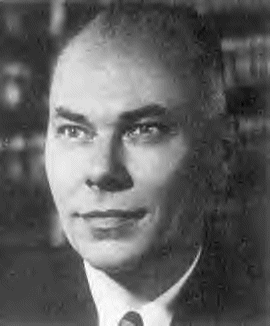
My understanding was that Aiken felt he had invented the computer and
was not receiving adequate recognition for his work. At that time Harvard
had two computers: the Harvard Mark I 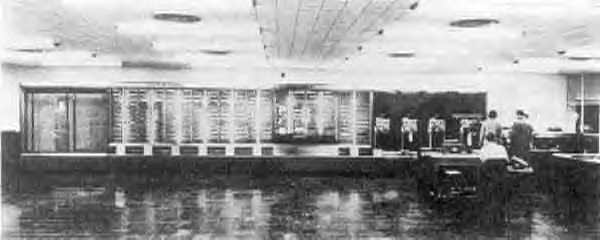
and the Harvard Mark IV (actually, the Mark III may have been there
when I first visited the laboratory, but the Mark IV was at least under
construction). The Mark I had been jointly developed with IBM and in IBM
literature it is referred to as the ``IBM automatic sequence controlled
calculator'' However Aiken had had a falling out with IBM and I was advised
never to mention IBM in his presence. The Mark I had been built in 1944
and was not really a computer in the modern sense, in particular it lacked
the ability to manipulate its program -- it was a decimal machine made
out of ten position stepping relays, and was programmed by means of paper
tapes that were the width of IBM cards and were thus, I assume, read by
IBM card readers. It has been designed to compute tables for such things
as naval ordnance and Bessel functions. It did a grand total of three operations
a second with considerable accompanying noise. The Mark IV was a
more modern computer which I'll discuss a little later.
I also discovered at this time that there was a course about ``modern
computer design '' offered by the University and that the course would
be taught that spring. I have forgotten the name of the professor who was
offering the course. I do remember that it was not Aiken, this was fortunate
as I had enough trouble building up the courage to ask the professor if
I might sit in on the course for free. He was happy to have me sit in and
to include me on the various field trips that were part of the course.
This was just before the invention of the transistor so the state of the
art was vacuum tubes and semi-conductor diodes. The big problem was memory.
A computer memory built out of vacuum tubes is very expensive. I can't
remember what was done on the Mark IV but I do remember taking a
field trip during that course where we saw a computer under development
at, I believe, the Raytheon corporation. In that computer the memory consisted
of mercury delay lines. These were boxes filled with mercury with, in effect,
a loudspeaker at one end and a microphone at the other, the contents of
the memory was a sequence of sound pulses that were sent through the box.  That
computer had something on the order of a memory for several hundred thirty-six
or so bit words. Physically the memory consisted of a mercury delay line
for each bit -- that is, thirty six boxes operating in parallel.
They were very proud of this memory even though it was not operating correctly
on the day of our visit. And, I should add, we were also very impressed.
That
computer had something on the order of a memory for several hundred thirty-six
or so bit words. Physically the memory consisted of a mercury delay line
for each bit -- that is, thirty six boxes operating in parallel.
They were very proud of this memory even though it was not operating correctly
on the day of our visit. And, I should add, we were also very impressed.
On the basis of my score on the civil service exam and on the basis
of having audited the above mentioned class I received a number of job
offers for that summer and accepted one at the Bureau of Standards in Washington
DC as a student aid trainee in their computation laboratory. Because of
my major in physics I was given a position in their components research
group. My job was not all that interesting as it consisted largely of collecting
data on the aging of semiconductor diodes, but the place as a whole was
very interesting. Their computer at that time was the SEAC computer --
Standards Eastern Automatic computer (There was also a SWAC somewhere out
on the west coast). I was not allowed to use the computer -- it was a very
delicate machine with all its I/O on paper tapes. It was very temperature
sensitive and as a result all the air conditioning in the building was
dedicated to cooling the computer. Washington is very hot and humid in
the summer -- without air conditioning one tends to be covered with a thin
layer of perspiration all summer long. I was particularly aware of this
as I received a very large number of electric shock from my apparatus for
testing the semiconductor diodes. There was considerable emphasis on memory
at NBS. The main emphasis was on Williams tube storage -- this is a system
where cathode ray tubes are used for storage. Again, as with the mercury
delay lines, you have a CRT tube for each bit with the ith bit of many
words appearing on the ith CRT. You have a bright spot for a 1 and a blank
spot for a 0. A conducting film on the face of the tube is able to detect
whether the spot being scanned is bright or blank. Of course you have to
continually scan and refresh the image and, as with the delay lines, you
may have to wait until the scanners get to the desired word. They were
also working on magnetic core memory but with very large cores about the
size of my thumbnail. This was an exciting summer but by the end of it
I realized that I was more interested in the design of computers than in
the physics of components .
That fall I got a part time job in the chemistry department as a ``computer''
(How many people in this field can claim to have been a computer?). What
I did was solve sets of eight linear equations eight unknowns for
some chemists who were trying to determine the exact shape of a particular
tetrahedral molecule . The procedure was that they would do an experiment
and produce data in the form of the coefficients for the equations and
I would then invert the matrix using a Marchant mechanical calculator
and taking about 8 hours at $2 per hour. Fortunately for me, they had a
lot of trouble with their data collection and the computations never produced
a reasonable shape for the molecule (typically, on a scale where the base
triangle formed by three of the atoms would be about 10 cm on a side, the
fourth atom would be computed as being about a kilometer away). This paid
part of my way through college and was more interesting than being a waiter
in a restaurant -- my occupation during my first three years in college.
. By the way that the Marchant machine cost about $800 ($5000 NOK) you
can get a better machine today for 1/100 the cost.
That fall, when I returned to college I decided learn about the use
of computers and so enrolled in a course in numerical analysis that included
learning how to program the Mark IV. The programming part of the course
was taught by Ken Iverson who later on developed the programming language
APL. One of the course requirements was that we would have to write a program
and run it on the Mark IV -- I decided to program matrix inversion for
8x8 matrices. Programming the Mark IV was very difficult by today's standards.
For starters the programming as done completely in machine language. Instruction
were just strings of digits -- the first couple of digits represented the
operation codes and the remaining digits indicated which locations in the
memory were to be employed. there were no mnemonics or other aids -- all
addresses were absolute (what you wrote was what you got). Also there were
no index registers so in order to add together the contents of memory
locations 100 through 200 you had to either write 100 addition instructions
or write codes that directly modified your program as it ran. One saving
grace in all this is that the computer was decimal rather than binary so
all these computations were carried out in ordinary everyday familiar arithmetic.
Another complication was that the machine went through its instructions
at a fixed rate -- and if you did a division say at step 10 the result
would not be available until something like 10 times steps later i.e.,
at step 20 of the program. The programmer thus had a choice of either leaving
those steps blank or doing addition, subtraction and shift operations during
that time. Since the memory was rather small it was important to try to
be efficient and do things during these divisions and multiply gaps --
actually this problem still exists today on some machines but it is taken
care of by the compiler and so we never have to contend with it as long
as we avoid writing. compilers. The writing of the program to be run on
the Mark IV was one of the last events in the course. Despite having had
months to work on it I did most of the programming the night before the
program was to be run -- it was the only time in college when I actually
stayed up for the whole night. But, as you can see, all night hacking is
not a recent development The thing that made the project particularly difficult
was the manner of entering a program into the computer, The input was done
on magnetic tape . The problem was getting the program onto the magnetic
tape. This was done using on what I hope was one of the most primitive
devices in the history of computing. What you did was mount a tape on a
device that (relying on my memory of an event that took place forty years
ago) looked something like this slide.
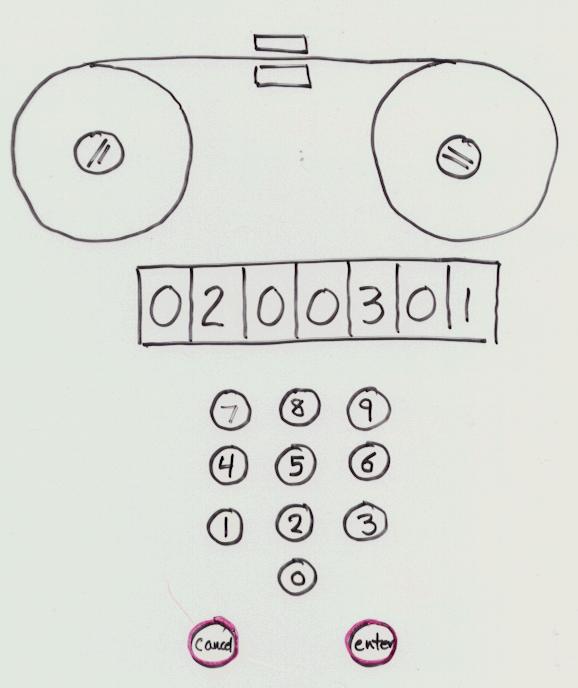
Then yoiur took your program and entered the instructions one by one
(number by number) by punching these keys -- as your punched the keys the
digits came up in these little window (a mechanical display -- no electronics)
if you entered a wrong digit you pushed the erase and started the line
over again -- if you got it right you pushed record and it was written
on the tape. There was no way to correct for a missed line except by writing
in a patch. At three or four n the morning it is extremely hard to operate
such a device and I was there for a long, long time. However, after a very
fast breakfast, I finally go on the machine. We mounted the tape on the
Mark IV, pushed the start button and, of course, got the wrong answer,
bugs have also been there since the beginning of computing. However, working
on the machine we (Iverson and I) were able to pinpoint all the bugs and
it was possible, once the program was in the machine , to modify the contents
of locations, and so, after about fifteen minutes I got the correct answer.
I knew it was correct since it was a matrix that I had inverted for the
chemists somewhat earlier (of course the molecule was still an impossible
shape). What did impress me considerably is that, once debugged the program
took less than a minute (30 seconds) to run. It was clear that I did not
have much of a future as a computer per se. since that made the Mark IV
about 500 to 1000 times as fast as I was .
During that same last year of college I also pursued my original interest
in AI like aspects of the subject -- I took a course on the physiology
of the nervous system and I took a course of probability and statistics
in the hope that these subjects would provide the necessary tools for making
some real progress in the area. I didn't find these courses to be very
encouraging even though they were interesting. However, I also took a course
in logic from Willard Quine and that was both interesting and useful. For
one thing it clearly provided tools that would be useful in the logical
design of computers and secondly it stimulated me to design a very small
relay computer for evaluating logical expressions. This activity in logical
design coupled with the need to get a job stimulated me to look for a position
in the then fledgling computer industry. I applied to a number of companies
but it was clear to me that IBM was the leader in the industry at that
time. When I accepted the position at IBM I recall telling Iverson about
it and his immediate remark was to be sure not to tell Howard Aiken about
it (I heeded this advice and so lived on to work at IBM).
1953 ...
I arrived at IBM at 8:30 in the morning on June 15, 1953. :IBM was
a much smaller company in those days and it was still under the direction
of Thomas J. Watson Sr -- the founder of the company.
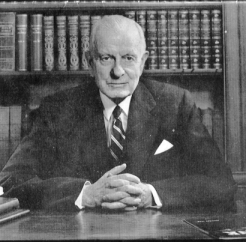 At that time IBM's major
business was in tabulating machines , card punches, card readers, typewriters,
time clocks, and other such mechanical devices. However it was becoming
obvious to IBM management that there was a lot of potential in the computer
market. I was told that the real decision to go into computers was not
made by Thomas J. Watson Sr. but rather by his son, Thomas J. Watson Jr.
Part of the story is that he decided that it would be very good for the
company's prestige and that, with a little luck, they might sell as many
as thirty-five computers. Whether or not that story is true is hard to
say, but certainly there were many people around at that time who did not
believe that computers were going to be much than special toys and tools
for scientists.
At that time IBM's major
business was in tabulating machines , card punches, card readers, typewriters,
time clocks, and other such mechanical devices. However it was becoming
obvious to IBM management that there was a lot of potential in the computer
market. I was told that the real decision to go into computers was not
made by Thomas J. Watson Sr. but rather by his son, Thomas J. Watson Jr.
Part of the story is that he decided that it would be very good for the
company's prestige and that, with a little luck, they might sell as many
as thirty-five computers. Whether or not that story is true is hard to
say, but certainly there were many people around at that time who did not
believe that computers were going to be much than special toys and tools
for scientists.
A good solid, reliable product in those days was electromechanical and
consisted of parts such as the following:
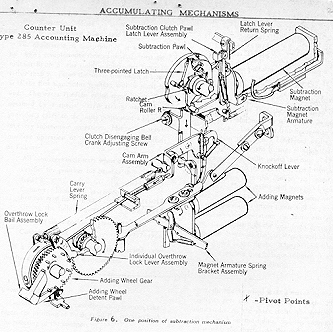 By the time I got to
IBM they had pretty well accepted the idea that there was money to be made
in the computer business. They were already offering the IBM 701 as a product
and I'll have more to say about that shortly. But I was hired to work,
as a logical designer on the SAGE computer. This was a big project done
jointly by IBM and MIT . At the time I joined the project the computer
was called something like the ANFSQ7 -- but later on it was renamed the
SAGE computer ( I have said for years that this stood for Simulated Air
Ground Environment -- and this may have been true at some time but the
official translation is somewhat different and despite having read it last
week I forgotten the last two words -- but it started out as Sequenced
Automatic something something). The purpose of the computer was to be able
to track all the airplanes in an area the size of the NE US in the event
of a Soviet air strike. However, Before describing the SAGE let me give
you some more idea about its precursors.
By the time I got to
IBM they had pretty well accepted the idea that there was money to be made
in the computer business. They were already offering the IBM 701 as a product
and I'll have more to say about that shortly. But I was hired to work,
as a logical designer on the SAGE computer. This was a big project done
jointly by IBM and MIT . At the time I joined the project the computer
was called something like the ANFSQ7 -- but later on it was renamed the
SAGE computer ( I have said for years that this stood for Simulated Air
Ground Environment -- and this may have been true at some time but the
official translation is somewhat different and despite having read it last
week I forgotten the last two words -- but it started out as Sequenced
Automatic something something). The purpose of the computer was to be able
to track all the airplanes in an area the size of the NE US in the event
of a Soviet air strike. However, Before describing the SAGE let me give
you some more idea about its precursors.
Of course there were some business machines around before my time at
IBM that were predecessors of the computer. One that I never saw was the
Selective Sequence Electronic Calculator that came out in 1948 -- I think
they only made one (and it may have also been done in collaboration with
Harvard -- but I couldn't tell from the literature of the time). That computer
had 20,000 words of paper tape storage (66 readers reading loops of papers
tape of the width of IBM cards. 150 words of relay memory and 8, yes eight,
words of electronic memory. It could perform a multiplication in 20 milliseconds.
The significance of this machine is that it was ``the first operating computer
with instructions treated like data. '' That is actually a quote from some
IBM literature and I think that the word ``operating'' is probably very
significant as John von Neuman is generally regarded as having designed
the first computer in which instructions were treated like data and this
was not the SSEC but the ``Jonniac '' at the Institute for advanced study
in Princeton.
One of the precursors I did get to see and program during my first summer
at IBM, this was the IBM 604 -- this was a n actual product. It had the
capability of performing a program with 60 three address instructions.
The program was first designed on a piece of paper that looked like this
and was then wired into the computer using a wiring panel or plug board
that looked like this. To figure out the wiring one used a piece of paper
that could be laid over the plug board after one had drawn the wires on
it. Here is an actual one from forty years ago with my wired program on
it.
[Sorry, I couldn't get my program to copy
properly -- but here is an example from the manual for the
IBM 604]. It is easy to see that this
way of programming is very messy -- it makes GOTOs look positively benevolent. 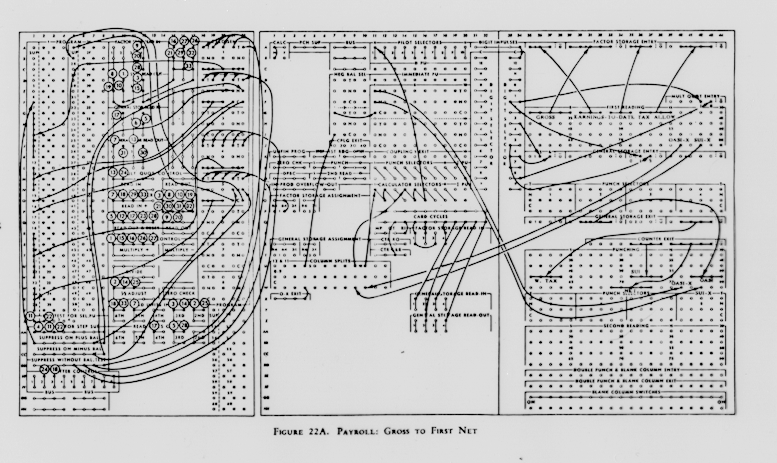
The 604 was superseded by the 607. Here is a picture of this worthy
device
 and here is an article
about it from an edition of The IBM Record from April (?) 1953. I
have underlined some of the material that is particularly interesting.
and here is an article
about it from an edition of The IBM Record from April (?) 1953. I
have underlined some of the material that is particularly interesting.
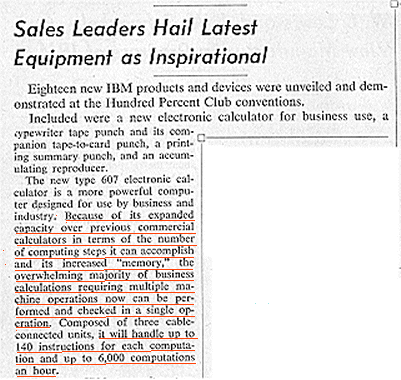
If you compare the material with the red and the blue underline, I think
you see some reflection of the belief , widely held at that time,
that there was not much of a market for really large computers.
However, the first of the real IBM computers came out essentially at
the same time as I joined IBM. This was the 701. While cleaning out my
office prior to retiring from IBM I found an advertising flier for
the 701. Here is the picture of it from that flier (I have edited the background
to make it a uniform color and I have removed text that was impossible
to read).
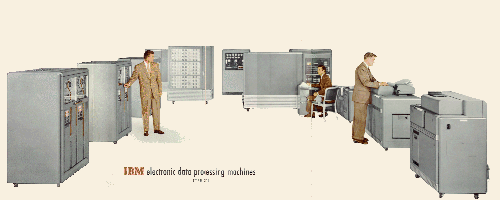
As you can see , this is a physically large machine. with many parts.
There are eleven different boxes, from left to right we have: Two Magnetic
tape drives, Magnetic drum storage, power supply, electrostatic storage
(Williams tube), power control and distribution, computing and control,
operator panel, card reader, printer and card punch. However, if we look
closer we find that, by today's standards, this machine is very small.
According to the brocure,
Each reel of magnetic tape can "store more than 2,000,000 digits",
each magnetic drum can "store 40,960 digits" and the William's tube storage
can "store 10,240 digits".
Another way of looking at the size of the Williams tube storage is
that is consisted of 2048 "words" each consisting of 36 bits.
The fast storage, the Williams tubes, had an access time of 12 one-millionths
of a second. i.e. 12 micro-seconds per cycle. Addition took 5 cycles and
multiplication and division both took 38. However, despite the fact that
701 did not have index registers nor an assembly language of
any consequence, it was much easier to program than the Mark IV largely
because of the use of IBM cards as an input medium.
There were some shortcomings however. These early computers were not
very reliable. There was no internal checking and programs had to contain
lots of checking and also had to print out intermediate results so that
not all would be lost in the event of a hardware failure. The degree of
unreliability is illustrated by the following:
The williams tube storage was very photogenic. 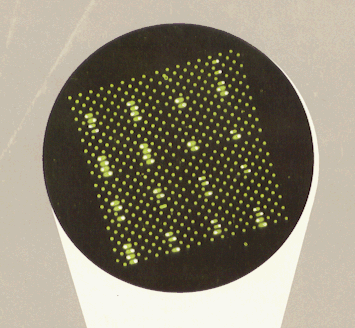
The motion of the dots of storage gave ;you a picture of the computer
in operation that intrigued visiting dignitaries. As a result it was the
practice at IBM's main office in New York to photograph such visiting dignitaries
in front of the williams tube storage. The computer was so generally unreliable,
and broke down so frequently, that it was some time before they realized
that each time they took such a photograph the flash of the flash bulb
completely erased the williams storage.
The 701 was a vacuum tube computer and the tubes were gathered in modules  a
long way from a modern silicon chip. But it does explain why the
computer took up so much space.
a
long way from a modern silicon chip. But it does explain why the
computer took up so much space.
SAGE
The SAGE (Semi-Automatic Ground Environment) computer was both IBM's first
really big computer project and also its last vacuum tube computer. The
purpose of the computer was to track airplanes in the event of a Soviet
attach on the United States. These computers we also known as the
AN/FSQ-7 computers, for Army-Navy Fixed Special eQuipment. Each duplex
system contained over 50,000 vacuum tubes, weighed 250 tons and occupied
over an acre of floor space, and drove over 100 consoles.. It was built
out of modules (called "pluggable units") that were 1.5 feet long, a foot
high and 2.5 inches wide (about half a meter by a third of a meter
by 6 cm). each of which contained twelve vacuum tubes. I was in a group
that designed the control circuitry and that contained over one thousand
tubes For reasons of reliability, the computer was designed with two of
everything. With several thousand tubes all going at once there must have
been quite a problem keeping it cool. However the tubes had one advantage
over transistors, when the machine went down the most common problem was
a burned out tube and that could be detected by turning out the lights
and looking for a tube that was not glowing . The redundant design, by
the way, was very successful, the true down-time when the whole machine
was down was very very low, generally hardware failure in half of the dual
machine could be detected and corrected before the other half developed
a problem. The memory consisted of magnetic cores wired together
in planes consisting of 4096 magnetic cores: little ferrite donuts
inside dimensions 50 mil and outside dimension 80 mil (1 mil = 1/1000
of an inch = 0.00254 cm).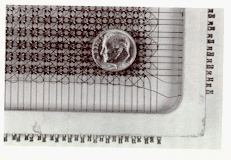 The
picture shows a corner of one of the planes with a U.S. dime resting on
it. Four wires pass through each ferrite core. Four wires passes
through each core. I was told, at the time, that the cores
were all wired by women since they had more patience than men, and that
it took three months to wire a plane and that after completing a plane
they were give a month of vacation.
The
picture shows a corner of one of the planes with a U.S. dime resting on
it. Four wires pass through each ferrite core. Four wires passes
through each core. I was told, at the time, that the cores
were all wired by women since they had more patience than men, and that
it took three months to wire a plane and that after completing a plane
they were give a month of vacation.
As I said above, I worked on the design of the control circuitry. I
found that my knowledge of logic was useful in logical design and that
designing a computer had a lot of satisfactions. But I also felt that there
were many problems of a theoretical nature that were more interesting than
the day to day problems of engineering design. While logic was useful,
minimization was very difficult and eventually it was thinking about this
problem that lead me to become a researcher rather than an engineer. There
were also lots of other problems of design . One that was answered shortly
after that time was how to handle the endless drawing and redrawing of
logical diagrams. This took a lot of time and was a very boring job
for the draftsmen since the drawing consisted of nothing but little boxes
with arrows connecting them. The answer of course was to let
the computer do it rather than a small army of bored draftsmen.. A much
more difficult problem was the laying out of wiring on the back panels
of the computer. Unless you have tried it you can barely imagine the feeling
of frustration one has when you lay out several hundred wires and and discover
that there are still five more wires to put in and the only feasible thing
to do is to start over. One of my co-worker became so tense from
doing wiring layouts that he began constantly losing things such as his
wallet, his car keys, his pen, etc. and was finally sent on vacation.
To be on the project we all had to get government clearance.
The first level of clearance, confidential clearance, did not take long
to get. However, we were then required to get secret clearance.
That took a long time and caused problems because something we had designed
could be classified secret and then we were not supposed to know anything
about it. In particular, it is very frustrating when, as the inventor of
some part of the computer, you are not allowed to read the documents
you have written about it People had this problem the whole
time I was on the project (from June 1953 until April 1954).
I left the project when I was drafted into the United States Army.
My clearance came though after I went into the Army, where, of course,
I didn't need it.
Upon my release from the army I returned to IBM, but as a researcher
on Switching Theory in their newly formed IBM Research Division.
This lead to IBM sending me to graduate school at Columbia for a PhD in
Mathematics. From there I returned to IBM where I stayed until
I retired in 1993. I continue to do mathematical research in
theoretical computer science.
Revised 2 September 2001


 While
the picture painted by Williamson did not encourage one to like robots
it did fire my imagination and get me started thinking about what is now
called artificial intelligence. It also made me interested in ``giant brains''
as computers were then called in the popular press on the rare occasions
when they received any attention at all. One day in the the library I came
across a book by Edmund C. Berkeley , titled Giant Brains or Machines
that Think (John Wiley and Sons, 1949) about actual computers.
Berkeley's book was possibly the first book on computers for the lay reader.
It had, as I recall, a lot of material on analog computers and computers
based on electro-mechanical technology, but there was some material on
electronic technology. This lead me to look for more material, but the
only other source of written information were a British electronics journal
which I found in the library and a couple of rather technical books that
I found in local bookstores. Despite this dearth of information I became
very interested in computers and artificial intelligence (a direct result
of reading science fiction).
While
the picture painted by Williamson did not encourage one to like robots
it did fire my imagination and get me started thinking about what is now
called artificial intelligence. It also made me interested in ``giant brains''
as computers were then called in the popular press on the rare occasions
when they received any attention at all. One day in the the library I came
across a book by Edmund C. Berkeley , titled Giant Brains or Machines
that Think (John Wiley and Sons, 1949) about actual computers.
Berkeley's book was possibly the first book on computers for the lay reader.
It had, as I recall, a lot of material on analog computers and computers
based on electro-mechanical technology, but there was some material on
electronic technology. This lead me to look for more material, but the
only other source of written information were a British electronics journal
which I found in the library and a couple of rather technical books that
I found in local bookstores. Despite this dearth of information I became
very interested in computers and artificial intelligence (a direct result
of reading science fiction).
 That
computer had something on the order of a memory for several hundred thirty-six
or so bit words. Physically the memory consisted of a mercury delay line
for each bit -- that is, thirty six boxes operating in parallel.
They were very proud of this memory even though it was not operating correctly
on the day of our visit. And, I should add, we were also very impressed.
That
computer had something on the order of a memory for several hundred thirty-six
or so bit words. Physically the memory consisted of a mercury delay line
for each bit -- that is, thirty six boxes operating in parallel.
They were very proud of this memory even though it was not operating correctly
on the day of our visit. And, I should add, we were also very impressed.

 At that time IBM's major
business was in tabulating machines , card punches, card readers, typewriters,
time clocks, and other such mechanical devices. However it was becoming
obvious to IBM management that there was a lot of potential in the computer
market. I was told that the real decision to go into computers was not
made by Thomas J. Watson Sr. but rather by his son, Thomas J. Watson Jr.
Part of the story is that he decided that it would be very good for the
company's prestige and that, with a little luck, they might sell as many
as thirty-five computers. Whether or not that story is true is hard to
say, but certainly there were many people around at that time who did not
believe that computers were going to be much than special toys and tools
for scientists.
At that time IBM's major
business was in tabulating machines , card punches, card readers, typewriters,
time clocks, and other such mechanical devices. However it was becoming
obvious to IBM management that there was a lot of potential in the computer
market. I was told that the real decision to go into computers was not
made by Thomas J. Watson Sr. but rather by his son, Thomas J. Watson Jr.
Part of the story is that he decided that it would be very good for the
company's prestige and that, with a little luck, they might sell as many
as thirty-five computers. Whether or not that story is true is hard to
say, but certainly there were many people around at that time who did not
believe that computers were going to be much than special toys and tools
for scientists.
 By the time I got to
IBM they had pretty well accepted the idea that there was money to be made
in the computer business. They were already offering the IBM 701 as a product
and I'll have more to say about that shortly. But I was hired to work,
as a logical designer on the SAGE computer. This was a big project done
jointly by IBM and MIT . At the time I joined the project the computer
was called something like the ANFSQ7 -- but later on it was renamed the
SAGE computer ( I have said for years that this stood for Simulated Air
Ground Environment -- and this may have been true at some time but the
official translation is somewhat different and despite having read it last
week I forgotten the last two words -- but it started out as Sequenced
Automatic something something). The purpose of the computer was to be able
to track all the airplanes in an area the size of the NE US in the event
of a Soviet air strike. However, Before describing the SAGE let me give
you some more idea about its precursors.
By the time I got to
IBM they had pretty well accepted the idea that there was money to be made
in the computer business. They were already offering the IBM 701 as a product
and I'll have more to say about that shortly. But I was hired to work,
as a logical designer on the SAGE computer. This was a big project done
jointly by IBM and MIT . At the time I joined the project the computer
was called something like the ANFSQ7 -- but later on it was renamed the
SAGE computer ( I have said for years that this stood for Simulated Air
Ground Environment -- and this may have been true at some time but the
official translation is somewhat different and despite having read it last
week I forgotten the last two words -- but it started out as Sequenced
Automatic something something). The purpose of the computer was to be able
to track all the airplanes in an area the size of the NE US in the event
of a Soviet air strike. However, Before describing the SAGE let me give
you some more idea about its precursors.

 and here is an article
about it from an edition of The IBM Record from April (?) 1953. I
have underlined some of the material that is particularly interesting.
and here is an article
about it from an edition of The IBM Record from April (?) 1953. I
have underlined some of the material that is particularly interesting.



 a
long way from a modern silicon chip. But it does explain why the
computer took up so much space.
a
long way from a modern silicon chip. But it does explain why the
computer took up so much space.
 The
picture shows a corner of one of the planes with a U.S. dime resting on
it. Four wires pass through each ferrite core. Four wires passes
through each core. I was told, at the time, that the cores
were all wired by women since they had more patience than men, and that
it took three months to wire a plane and that after completing a plane
they were give a month of vacation.
The
picture shows a corner of one of the planes with a U.S. dime resting on
it. Four wires pass through each ferrite core. Four wires passes
through each core. I was told, at the time, that the cores
were all wired by women since they had more patience than men, and that
it took three months to wire a plane and that after completing a plane
they were give a month of vacation.